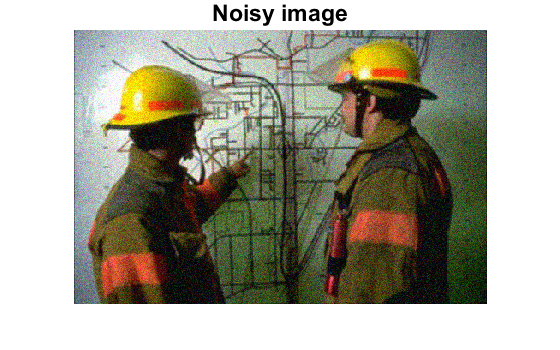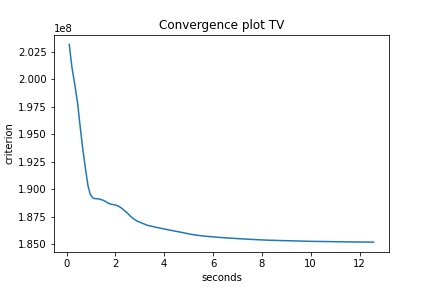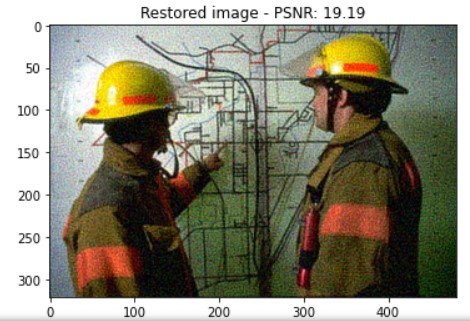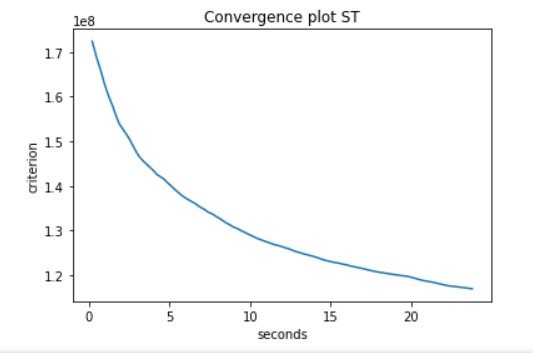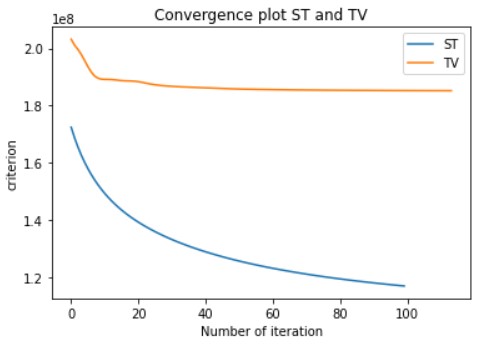% forward finite differences (with Neumann boundary conditions)
hor_forw = @(x) [x(:,2:end,:)-x(:,1:end-1,:), zeros(size(x,1),1,size(x,3))]; % horizontal
ver_forw = @(x) [x(2:end,:,:)-x(1:end-1,:,:); zeros(1,size(x,2),size(x,3))]; % vertical
% backward finite differences (with Neumann boundary conditions)
hor_back = @(x) [-x(:,1,:), x(:,1:end-2,:)-x(:,2:end-1,:), x(:,end-1,:)]; % horizontal
ver_back = @(x) [-x(1,:,:); x(1:end-2,:,:)-x(2:end-1,:,:); x(end-1,:,:)]; % vertical
% direct and adjoint operators
h.dir_op = @(x) cat( 4, hor_forw(x), ver_forw(x) );
h.adj_op = @(y) hor_back( y(:,:,:,1) ) + ver_back( y(:,:,:,2) );
% operator norm
h.beta = 8;
% regularization parameter
lambda = 5;
% proximity operator
h.prox = @(y,gamma) prox_L2(y, gamma*lambda, 4);
% criterion
h.fun = @(y) fun_L2(y, lambda, 4);
from proximityOperator import L2Norm
def hor_forward(x):
""" Horizontal forward finite differences (with Neumann boundary conditions) """
hor = np.zeros_like(x)
hor[:,:-1,:] = x[:,1:,:] - x[:,:-1,:]
return hor
def ver_forward(x):
""" Vertical forward finite differences (with Neumann boundary conditions) """
ver = np.zeros_like(x)
ver[:-1,:,:] = x[1:,:,:] - x[:-1,:,:]
return ver
def hor_backward(x):
""" Horizontal backward finite differences (with Neumann boundary conditions) """
Nr, Nc, Nb = x.shape
zer = np.zeros((Nr,1,Nb))
xxx = x[:,:-1,:]
return np.concatenate((zer,xxx), 1) - np.concatenate((xxx,zer), 1)
def ver_backward(x):
""" Vertical backward finite differences (with Neumann boundary conditions) """
Nr, Nc, Nb = x.shape
zer = np.zeros((1,Nc,Nb))
xxx = x[:-1,:,:]
return np.concatenate((zer,xxx), 0) - np.concatenate((xxx,zer), 0)
class TotalVariation(L2Norm):
beta = 8
def __init__(self, gamma):
L2Norm.__init__(self, gamma, direction=3)
def dir_op(self, x):
h = hor_forward(x)
v = ver_forward(x)
return np.stack((h,v), 3)
def adj_op(self, y):
h = hor_backward( y[:,:,:,0] )
v = ver_backward( y[:,:,:,1] )
return h + v
#def fun(self, x) --> inherited from L2_Norm
#def prox(self, x) --> inherited from L2_Norm
# hyperparameter
gamma = 5
# regularization
h = TotalVariation(gamma)

